EDITOR’S NOTE: Traveleater Elise Ofilada shares with us 20 traditional Pakistani dishes you need to try on your next trip to Pakistan.
From the highest peaks of the Himalayas to the sandy coasts of the Arabian Sea, Pakistan is a country in South Asia known for its extraordinary natural wonders. Whether it’s a historically significant mountain pass or a stretch of river that nursed an ancient civilization, this Islamic republic’s beautiful landscapes paint a vibrant portrait of human development.
As such, people who travel for food are sure to marvel at the diverse cultures the nation has to offer. With an immense population of nearly 243 million people, Pakistan is said to be the 5th most populous country in the world.
Because of that, it would be a grave injustice to describe its people and their social customs in a homogenous manner. In fact, Pakistani culture shares many similarities with its neighbors, Afghanistan and India.
That said, traveling to Pakistan is a one-of-a-kind experience. Over time, the country has become popular amongst tourists, with millions of travelers flocking to Pakistan every year.
Furthermore, it’s impossible for their people not to have acquired a taste for great food, given the nation’s long and elaborate past. That’s how all the best culinary traditions are born, after all.
With that, pack your bags and hop on a flight to the country as soon as possible! Traveleaters will be pleased to learn that the sensational aspects of Pakistan’s scenery and history translate into their expansive cuisine as well.
Save This on Pinterest!
No time to read this article on popular Pakistani foods? Click on the save button and pin it for later!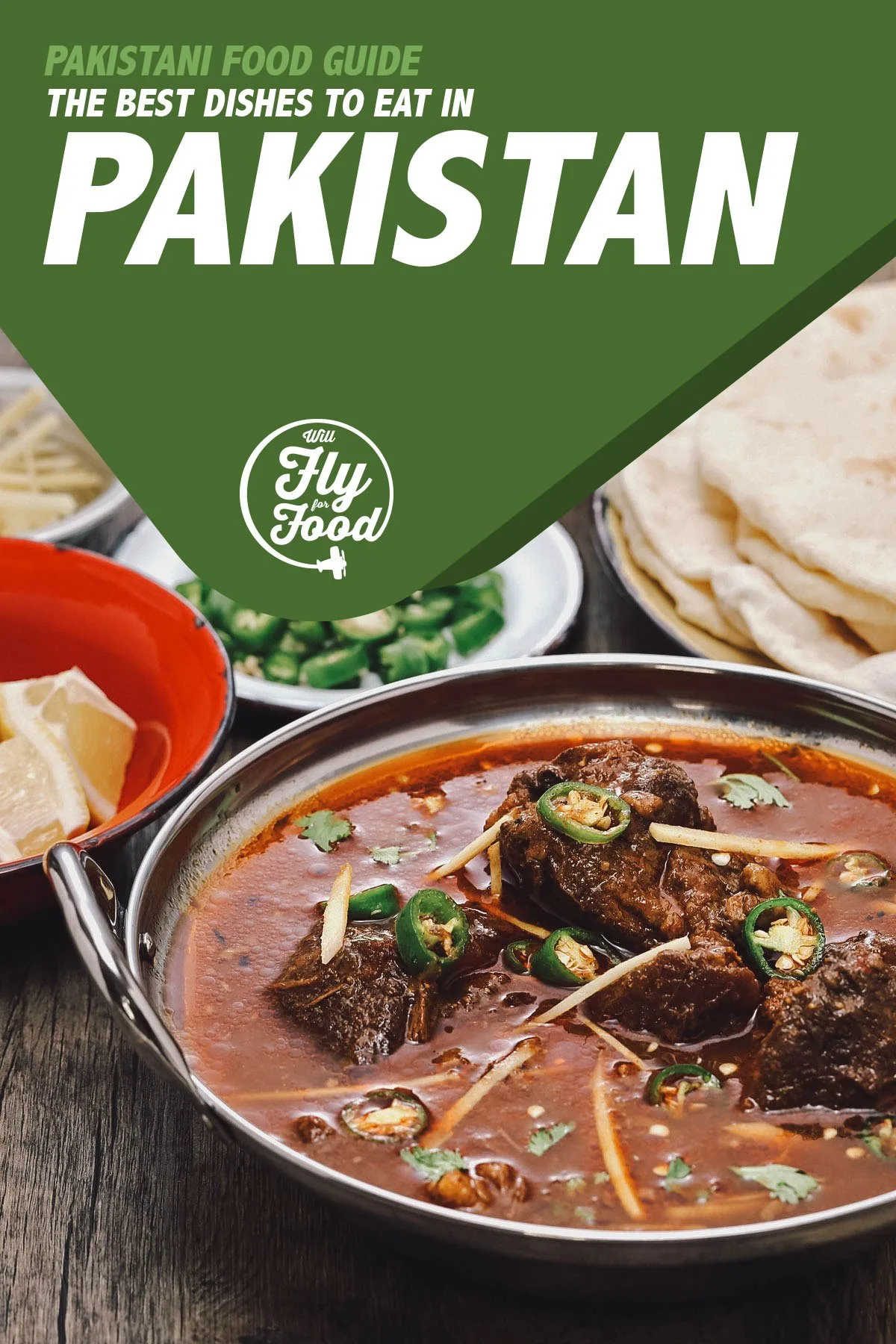
Photo by bonchan
WHAT IS TRADITIONAL PAKISTANI CUISINE?
Pakistani cuisine takes its cues from a variety of sources. Empires, such as the Mughal Empire and the British Empire, have made their mark on the kinds of food that the nation commonly serves.
Several countries in Southern and Central Asia have also shared their recipes with Pakistan throughout history. Regional variations of popular Pakistani dishes have become quite abundant as well.
Pork, you might notice, is not present in Pakistani cooking, as a majority of Pakistan’s population is Muslim. As such, the meats used in their dishes will often be a choice among chicken, lamb, or mutton.
Alcohol, too, is considered haram (forbidden) and is scarcely served with any meal. Pakistanis are more likely to enjoy beverages like yogurt-based lassi or hot tea.
Be it spicy curries or unleavened wheat bread, Pakistan has a spectrum of flavors just waiting to be explored. When presented with the country’s most famous dishes, Traveleaters won’t be able to resist digging into all the delicious foods that the nation has to offer.
With a name that means “land of the pure”, Pakistan guarantees that its cuisine is simply too good to pass up.
MUST-TRY PAKISTANI DISHES
This article on the best Pakistani foods has been organized by category to make it easier to digest. Click on a link to jump to any section of the guide.
With Pakistan being a melting pot of cultures, it’s no surprise that its people take pride in serving meals of varying influences. As you book your next trip to the country, remember to look out for these 20 phenomenal Pakistani dishes!
STARTERS / SIDES / SNACKS
1. Samosa
Stuffed to the brim with savory fillings, samosas make for a great appetizer or snack. It’s an especially popular food during the month of Ramadan when it’s eaten at the end of the day to break the daily fast, otherwise known as iftar.
The dish is typically made with potatoes, peas, and ground meat – usually lamb, beef, or chicken. Whether triangular or cone-shaped, the pastry is meant to have a nice, crispy quality.
Samosas are highly popular in many countries throughout Asia and Africa like Pakistan, India, Nepal, Myanmar, and Ethiopia. It’s an extremely versatile dish that exists in many different versions throughout Pakistan.
In the eastern and southern regions of the country, samosas tend to be spicier and contain mostly potato or vegetable fillings. In the western and northern parts of Pakistan, they’re less spicy and more often made with minced meat fillings.
As such, samosas are a good example of why Pakistani cuisine is known to be culturally diverse. No matter the form, they’re best enjoyed with a side of tasty green chutney.
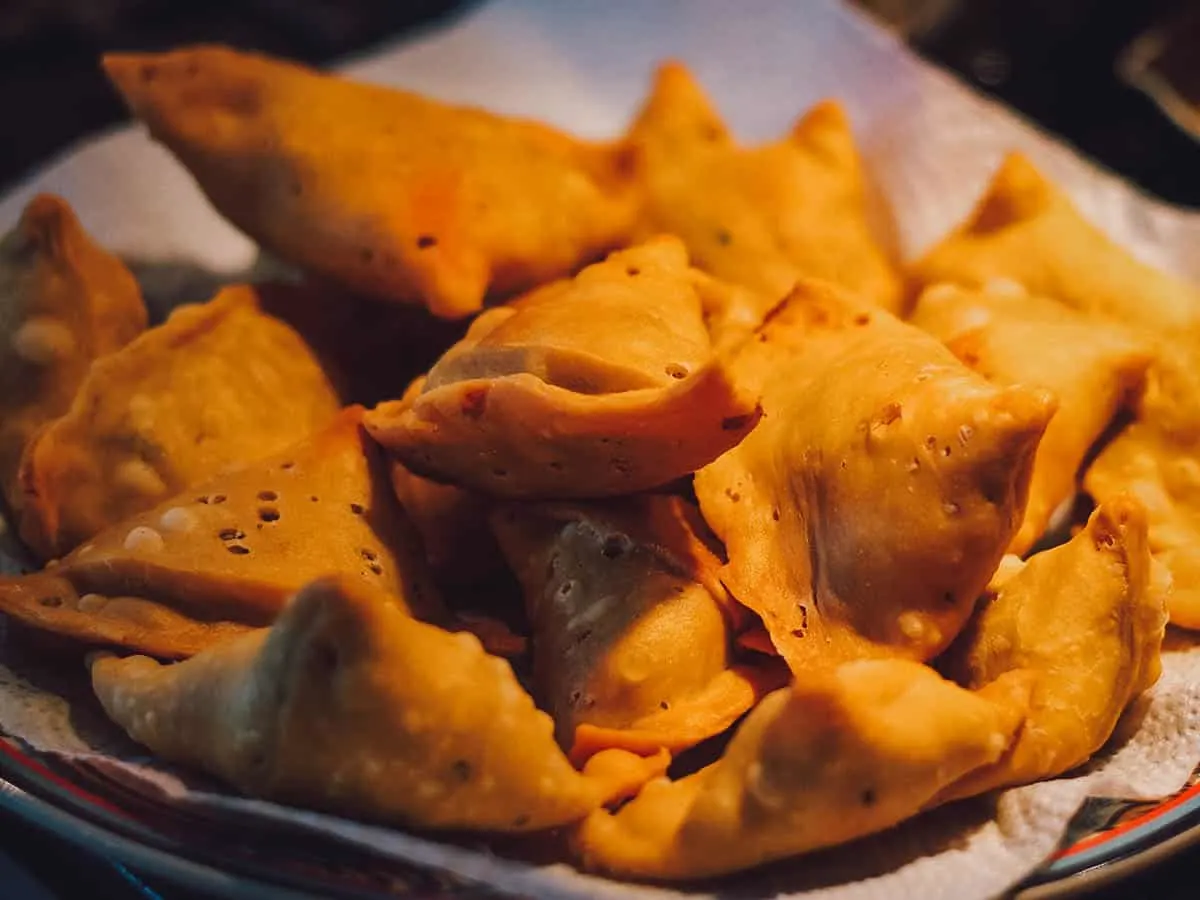
“Samosa” by Avinash Bhat, used under CC BY-SA 2.0 / Processed in Photoshop and Lightroom
2. Pakora
Pakora is another classic iftar staple and a popular street food in Pakistan. It essentially refers to any type of fritter that’s been coated with a batter of chickpea or gram flour. Spices like cumin and turmeric are added to give the deep-fried snack a little kick. A perfect batch will have a texture that’s just fluffy enough, and not too flat.
Only served once golden brown, pakoras can be composed of various ingredients. A number of recipes will call for vegetables like onions, eggplant, and potatoes. Many vendors, however, cook it using chicken meat. It’s also possible to make the snack with mushrooms, plantains, and taro roots.
Commonly consumed with tea, pakora is a delicious and highly addictive Pakistani street food dish that’s difficult to resist. I dare you to stop at just one!
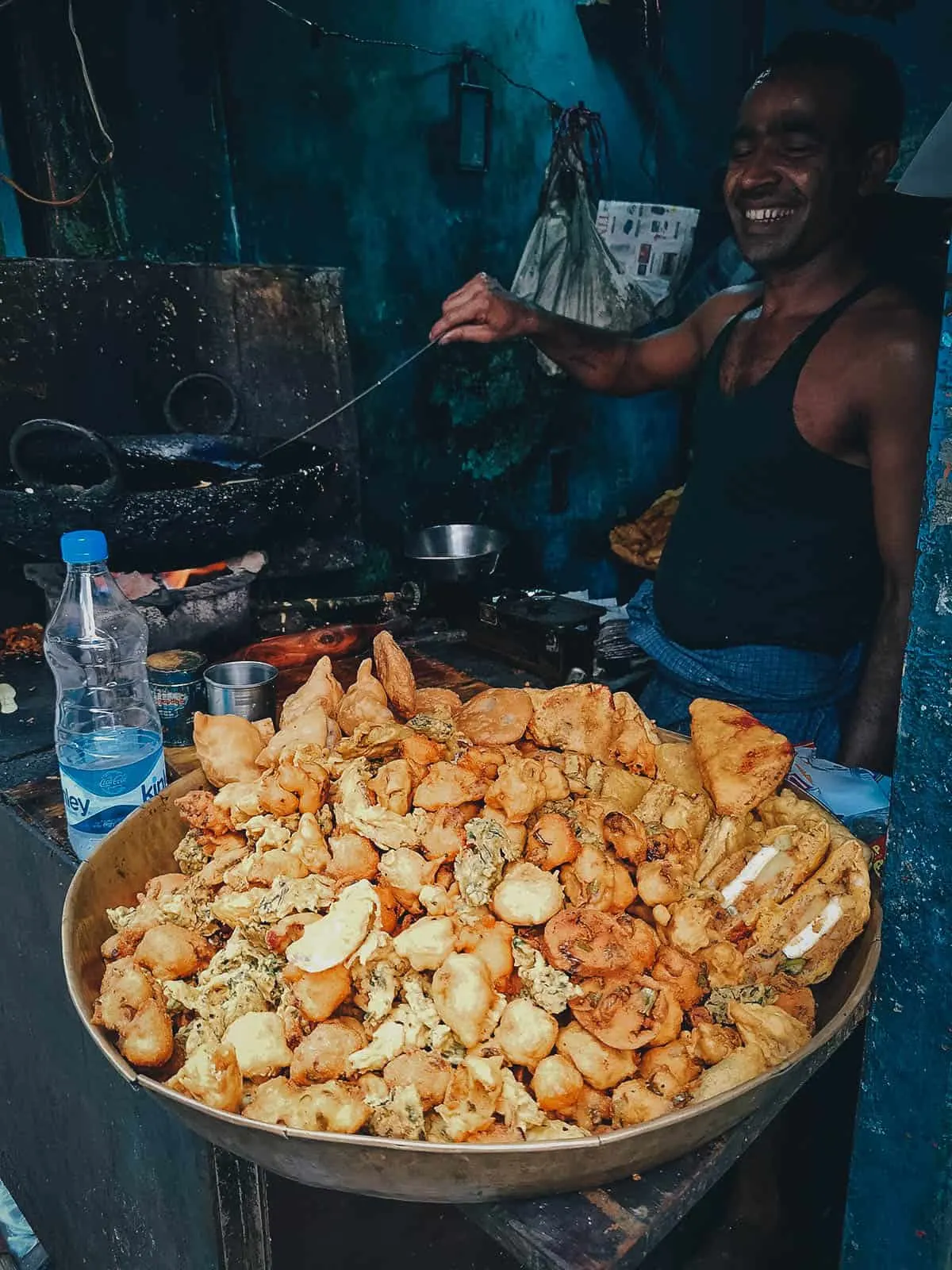
3. Gol Gappa
A true feast for the senses, gol gappa is an interesting Pakistani street food dish. Originally from India, it exists in many varations and is known by different names like pani puri, gupchup, or puchka. This beloved street food dish has a flavor profile that ranges from sour to spicy to sweet.
In essence, gol gappas are crispy fried hollow balls of dough (puri) loaded with a variety of fillings like boiled potatoes, chopped onions, chickpeas, tamarind paste, and mint chutney. They’re usually topped with a sprinkling of chaat masala and red chili powder and often accompanied by a tangy yogurt dip.
What makes gol gappa even more interesting is that each stuffed puri is filled with a spicy-sour liquid before being eaten whole. A beloved street food dish, especially among women, it needs to be eaten quickly before the delicate puri crumbles from the liquid.
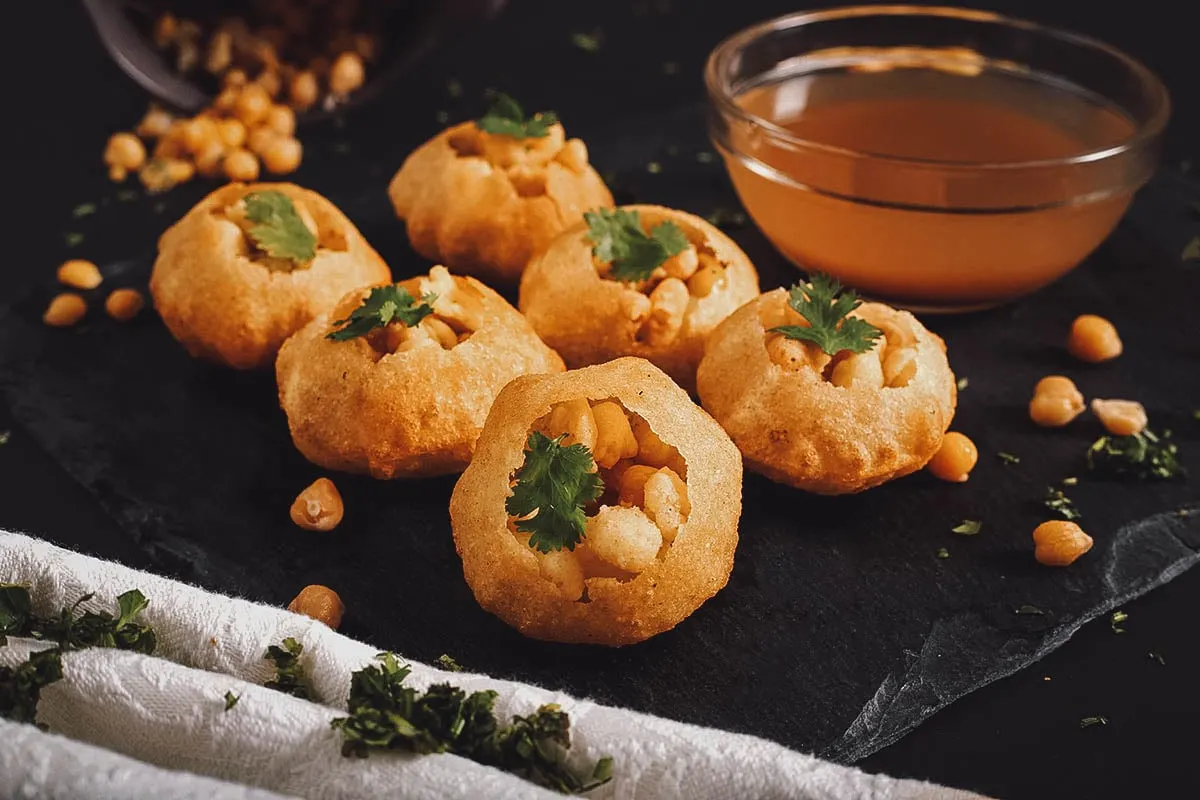
Photo by Arfa talib
CURRIES / STEWS
4. Lobia Ka Salan
Though Pakistani cuisine offers many exciting meat dishes, lobia ka salan is a vegan option that will entice even the staunchest carnivores. It’s a Pakistani curry made primarily with black-eyed peas and a base of garlic paste, onions, and tomato sauce.
The peas give lobia ka salan its nutty flavor while the various spices used to flavor the dish make for an aromatic gustatory experience. The stew is often topped with either green chilies or coriander and served hot for the whole family to enjoy.
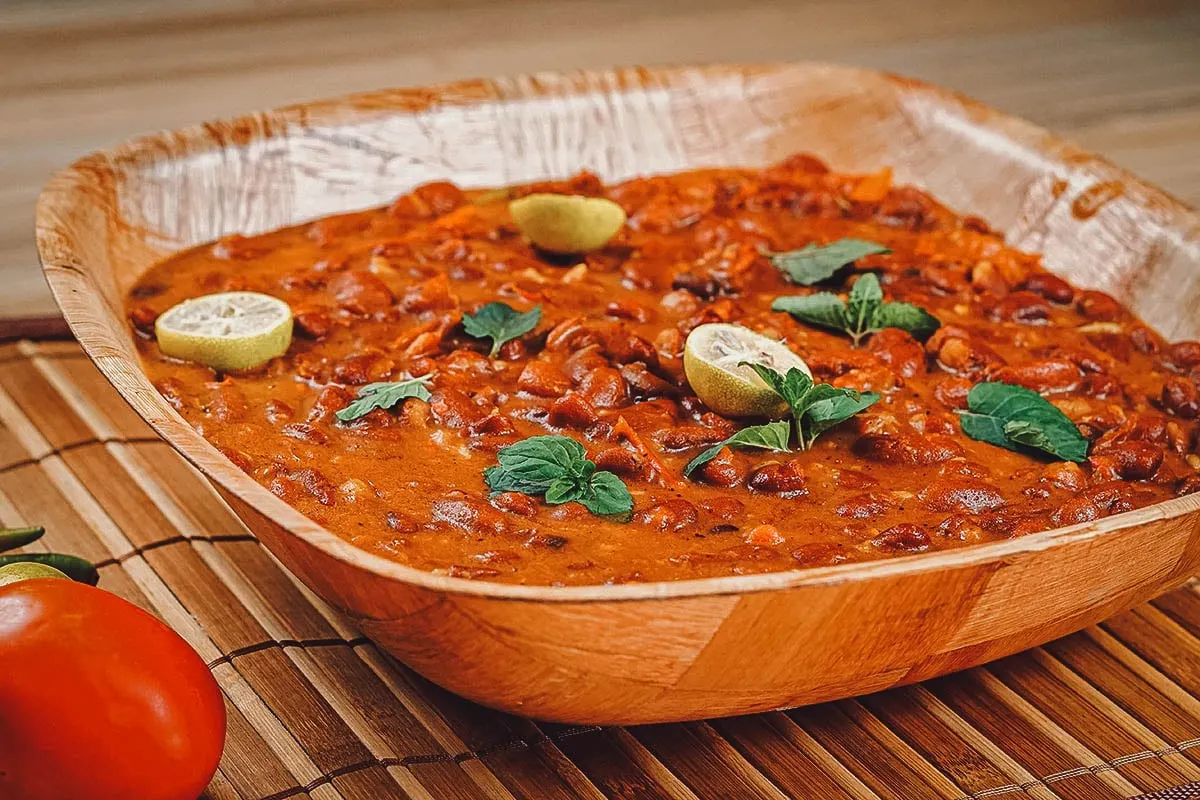
Photo by GR.Stocks
5. Aloo Gobi Matar
If you’re in the mood for a hearty Pakistani dish, then look no further than a simple but satisfying bowl of aloo gobi matar. Like many comforting Pakistani foods, it’s a meal that reminds people of home.
Aloo gobi matar is a healthy cauliflower and potato curry that consists mainly of potatoes, cauliflower, and peas. The dish can be cooked dry (similar to a plate of steamed vegetables) or served swimming in a spicy sauce. Both are delicious but personally, I prefer the latter.
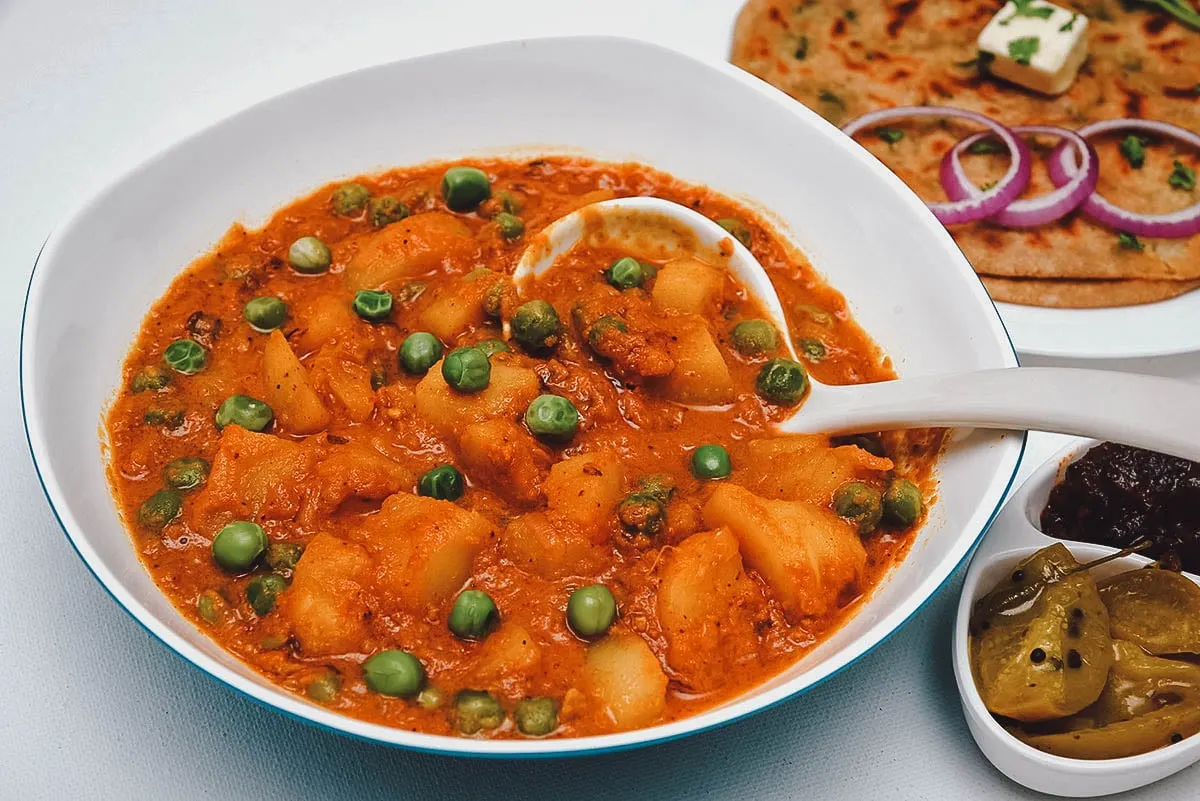
Photo by Santhosh Varghese
6. Haleem
Haleem (or daleem) refers to a type of Pakistani stew that’s widely consumed throughout the Indian subcontinent, the Middle East, and Central Asia. Originally from Iran, it can be found in different variations in countries like Pakistan, India, Afghanistan, Turkey, Uzbekistan, and Armenia.
Haleem typically consists of grains, legumes, meat (typically either chicken, lamb, or beef), spices, and a cooking liquid. The dish is slow-cooked for several hours until a smooth, paste-like consistency is achieved.
In Pakistan, haleem is a celebratory dish that’s often reserved for special occasions. Sour and tangy in flavor, it can be eaten with a spoon or some type of flatbread like naan bread.
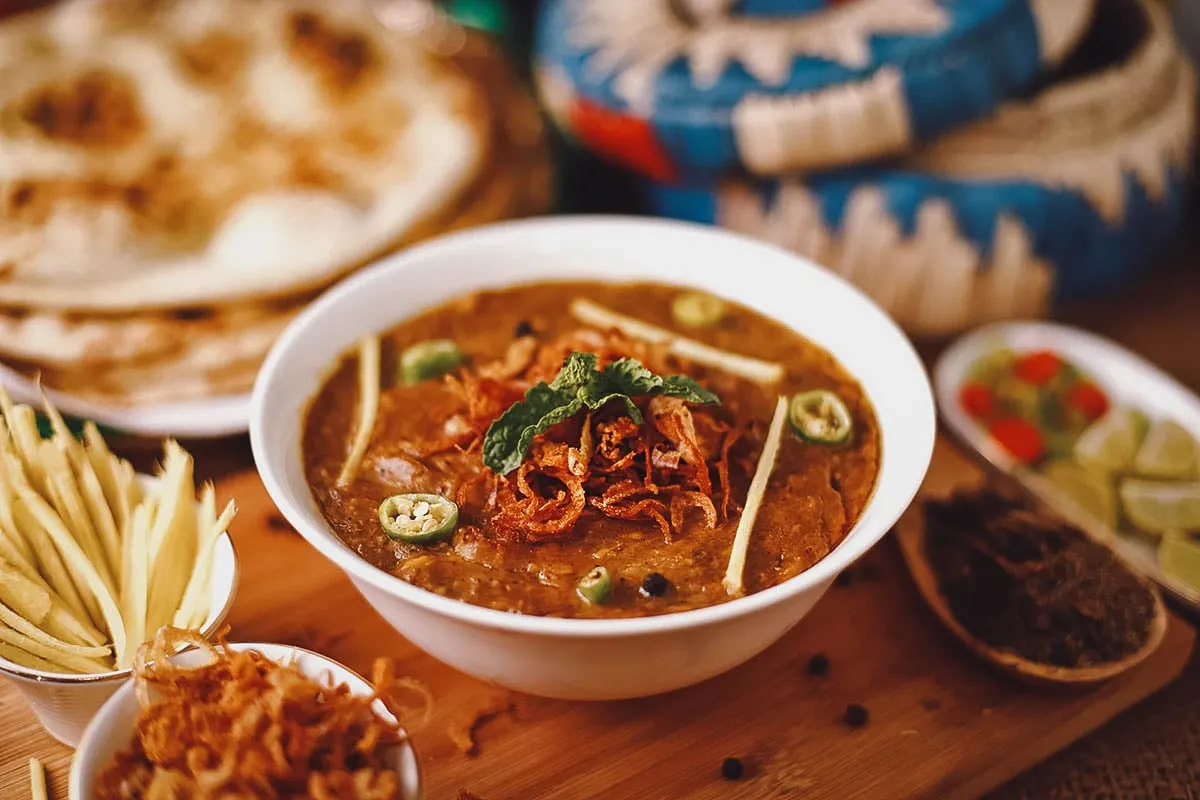
Photo by ahmer shahid
7. Nihari
Though nihari is mostly known as a traditional food that originated from the Indian subcontinent, its prominence in Pakistani cuisine can’t be overstated. Given how frequently it’s served in the country’s most populous cities, this tasty main dish strikes a balance between nourishing and appetizing.
Nihari is composed of tender beef shanks that sit in a stew thickened by durum whole wheat flour (atta). This Pakistani beef stew is delicious any which way but the most decadent versions are made with buttery bone marrow seeped into the stew.
Garnished with ginger and coriander and served with a side of naan bread, nihari is best when finished off with a good squeeze of lemon juice.
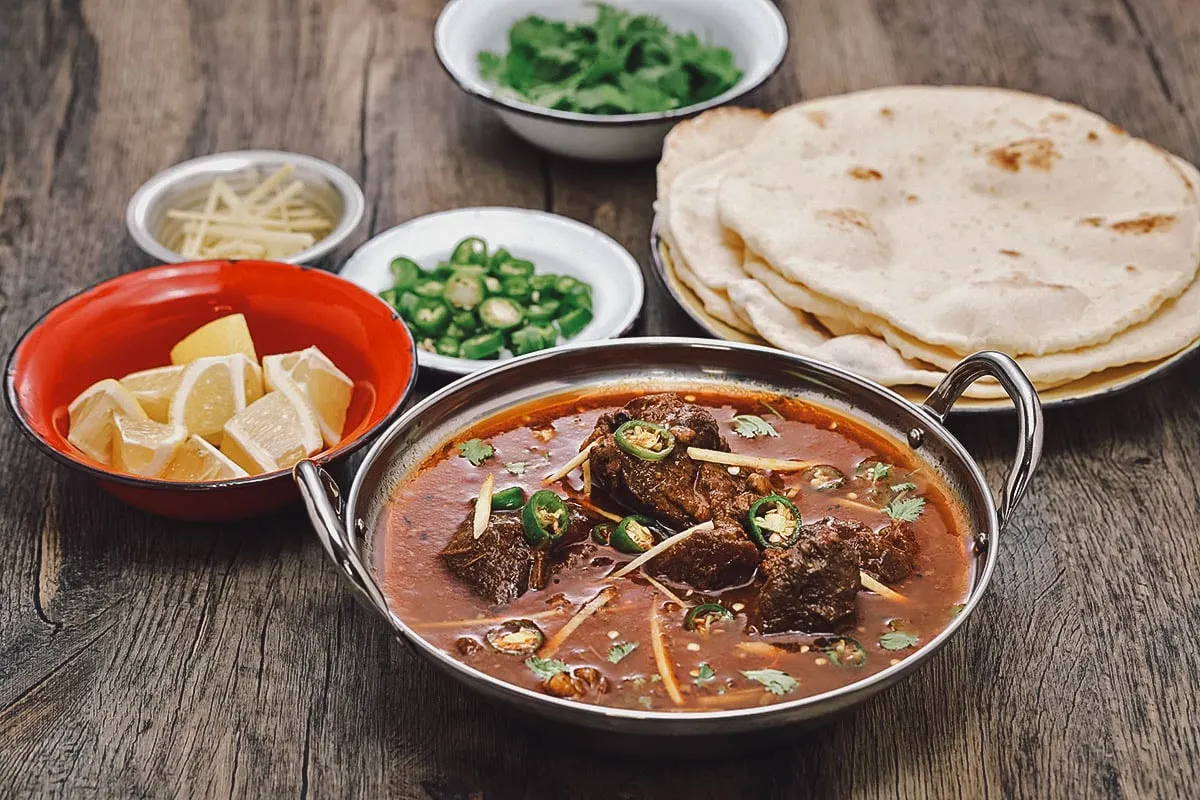
Photo by bonchan
MAINS
8. Chicken Sajji
Not all chicken dishes can compare to the most famous meal from Pakistan’s province of Balochistan – sajji!
Sajji, or Balochi sajji, refers to a style of cooking that entails rubbing a whole chicken with salt, skewering it, and then cooking it over an open fire. It’s traditionally made with goat or lamb but in modern times, chicken has become just as popular as well.
Though chicken sajji is similar to rotisserie chicken in that it’s also skewered and roasted, the meat is uniquely spiced with both chaat and garam masala. The chicken is meant to be extra juicy and soft as it’s traditionally cooked over an open fire through the night.
With a crispy skin that exudes a smoky flavor, chicken sajji is a delectable addition to Pakistan’s rich food culture.
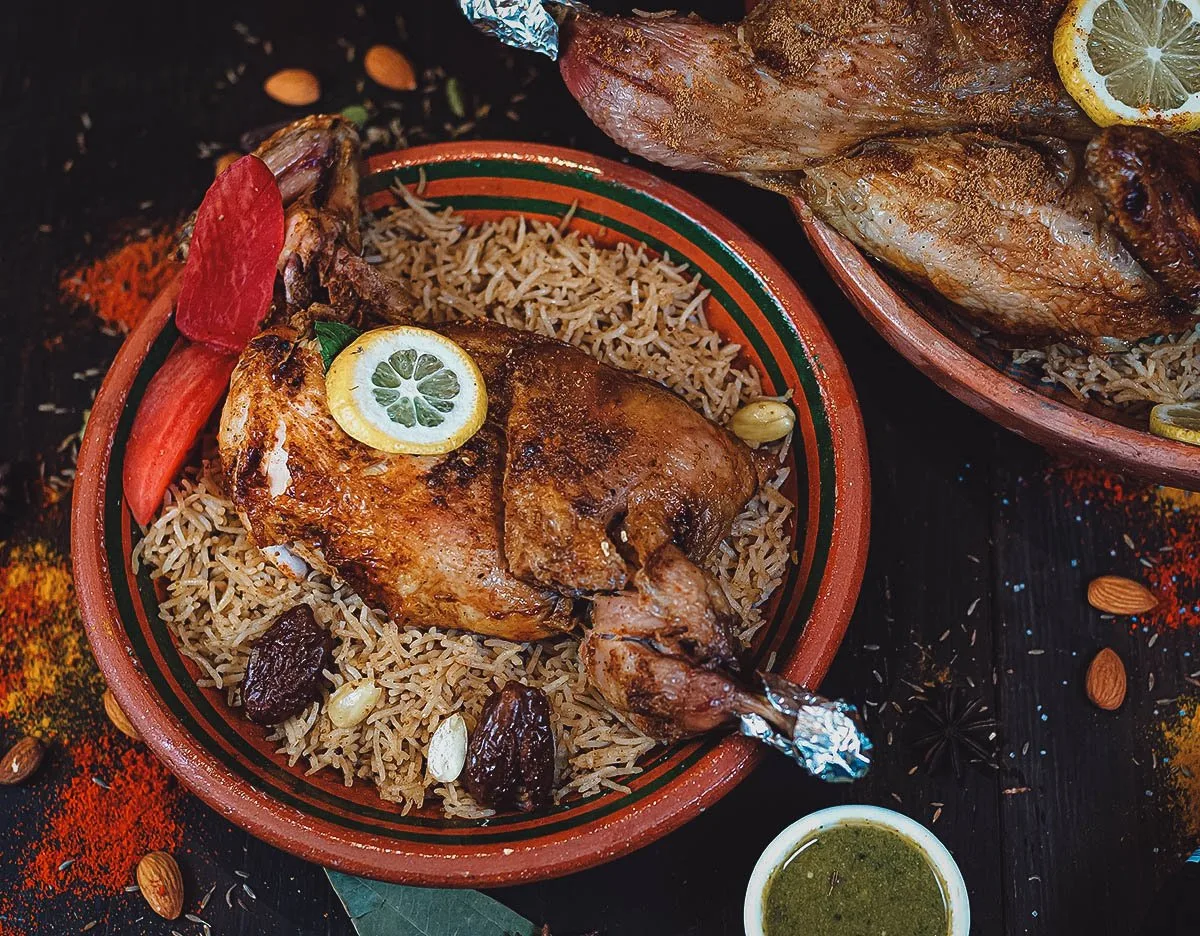
Photo by Fookis Labs
9. Chicken Karahi
Chicken karahi gets its name from the wok-like, cast-iron pan it was originally cooked in. It’s one of the most popular types of Pakistani curry and is said to have originated from the Khyber Pakhtunkhwa region of the country.
Karahi is known for its fragrant base made from fresh ginger, tomatoes, and garlic. Though modern recipes often include onions, the most traditional versions of chicken karahi are made without them.
Chicken is arguably the most popular but it’s worth noting that karahi can be made with other types of meat as well like lamb, beef, or fish. Like many other Pakistani dishes, it’s often topped with green chilies and coriander to amplify its inherently pungent flavors.
Whether found at Pakistani street restaurants called dhaba or cooked at home, the meal is most complete when served with a choice of basmati rice or naan.
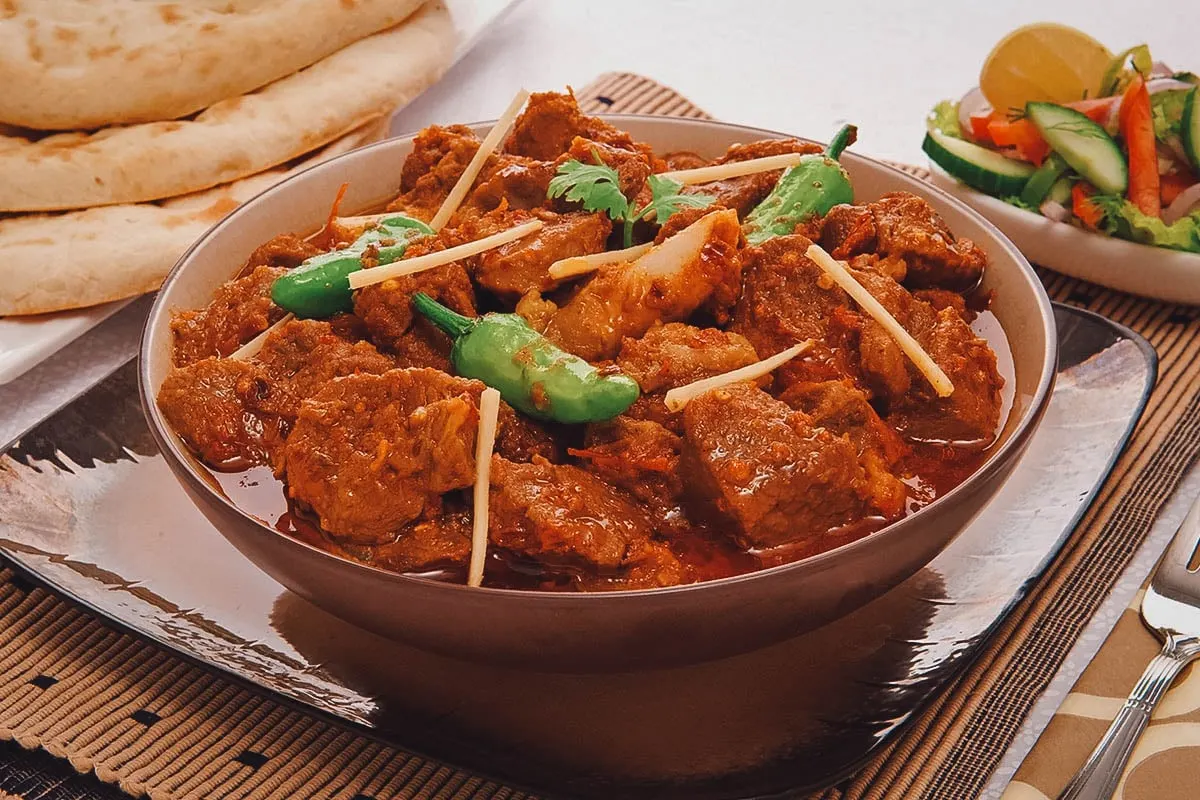
Photo by highviews
10. Chicken Tikka
This popular Pakistani dish dons an orange color that’s just as bright as its flavors. Though traditionally grilled over hot coals or cooked in a tandoor oven, modern versions can be cooked on top of a stove or baked inside an oven.
Marinated with spices like garam masala, cumin, and turmeric, chicken tikka sports a robust piquant flavor. Once nicely charred, it’s served with a spritz of lemon juice, in addition to either a mint or tamarind chutney.
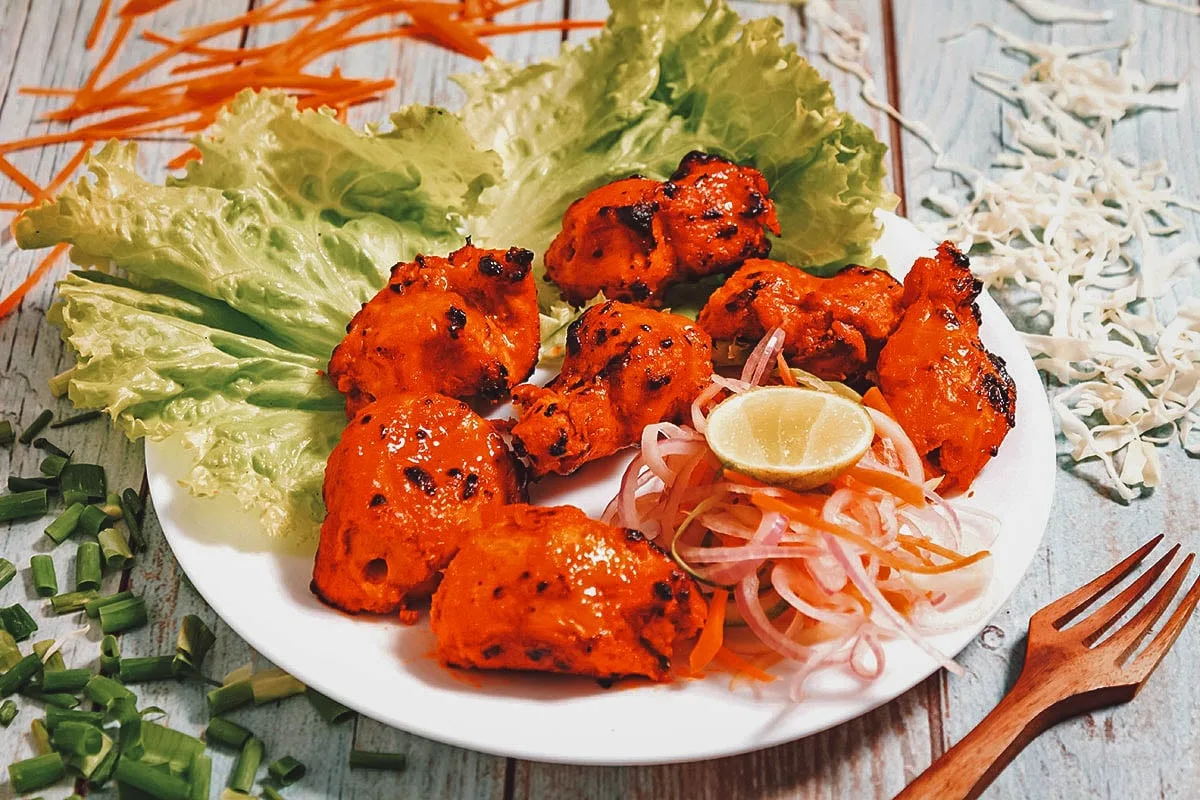
Photo by bhaskar deb
11. Seekh Kabab
Seekh kebab literally means “skewered meat cooked over fire”. In spite of its rather uninspiring name, it’s the kind of dish that’s guaranteed to exceed your expectations. After all, it’s hard to be disappointed by a grilled meat dish that promises fatty juiciness, a dash of heat, and a distinctly smoky flavor!
Indian-style seekh kebabs are typically made from ground lamb or chicken but the Pakistani version is most often made with beef. The minced beef is seasoned with garlic, onions, ginger, green chili peppers, spices, and herbs before being shaped into logs, skewered, and then grilled.
While seekh kebabs can be baked in an oven or pan-fried, they’re best when grilled or cooked over an open fire.
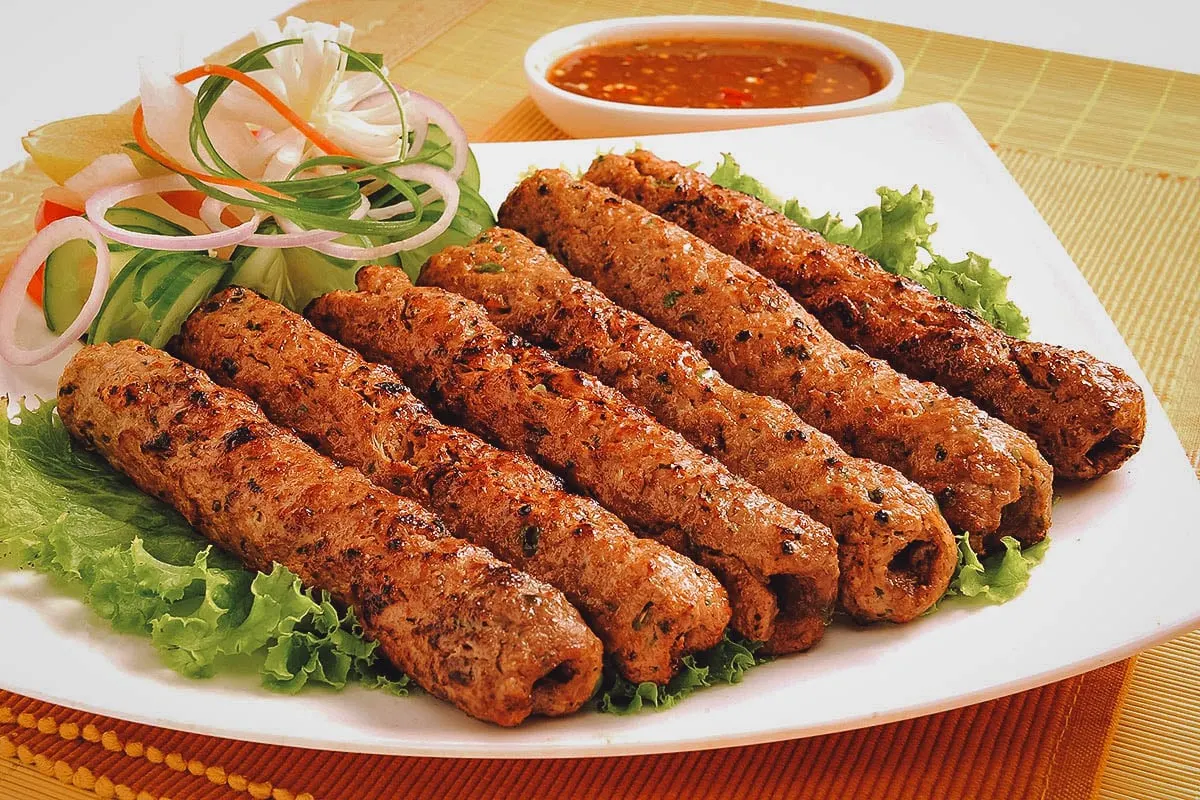
Photo by highviews
12. Chapli Kabab
Outwardly crispy yet soft once bitten into, chapli kababs are a signature dish of Pashtun cuisine. Originally from Peshawar in northern Pakistan (hence the alternate name peshawari kabab), they’re a popular street food in South Asian countries like Pakistan, India, Bangladesh, and Afghanistan.
Chapli kababs are flavorful patties made from minced meat (usually beef, mutton, or chicken) seasoned with a blend of coarsely ground herbs and spices like anardana (dried pomegranate seeds), coriander leaves, chili powder, and cumin. They’re shaped into patties before being shallow- or deep-fried in ghee (Indian clarified butter) or tallow (animal fat).
After cooking, this specialty of Pashtun cuisine can be served with various chutneys and yogurt and is often enjoyed with a side of rice or naan, or eaten like a sandwich (bun kebab).
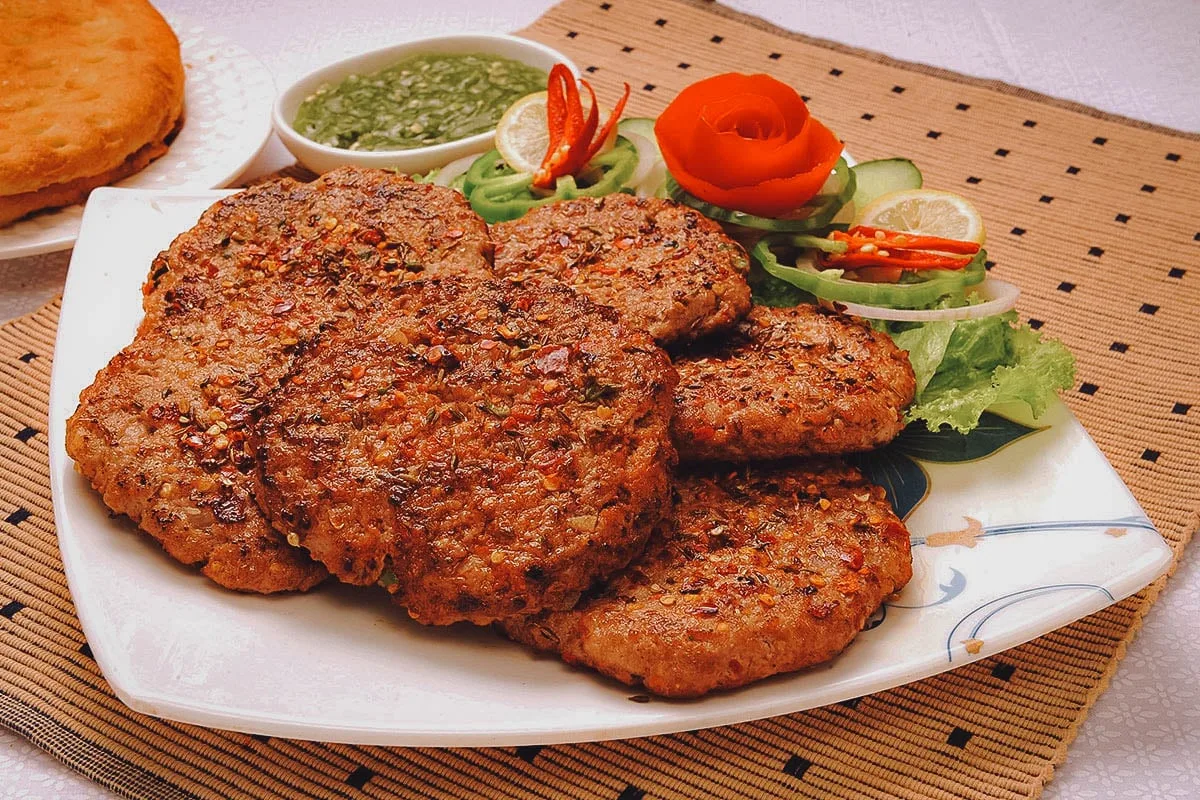
Photo by highviews
RICE / BREAD
13. Sindhi Biryani
Biryani is one of the most well-known rice dishes in the world, being a staple of both Pakistani and Indian cuisine. It can be topped with all sorts of viands (like chicken, fish, or goat meat) and is commonly eaten with a side dish of either eggs or spiced potatoes.
Biryani can be prepared in a number of ways using various ingredients. When cooked properly, the basmati rice should be fluffy with grains that don’t clump together.
You’ll find many different versions of biryani throughout the Indian subcontinent but sindhi biryani, which makes use of mutton, is the variation Pakistan is best known for.
Prepared for all kinds of events and special occasions, biryani is likely to be served hot after a round of Pakistani appetizers. Given its complexity and many variations, trying sindhi biryani or any other type of biryani is a must when visiting Pakistan.
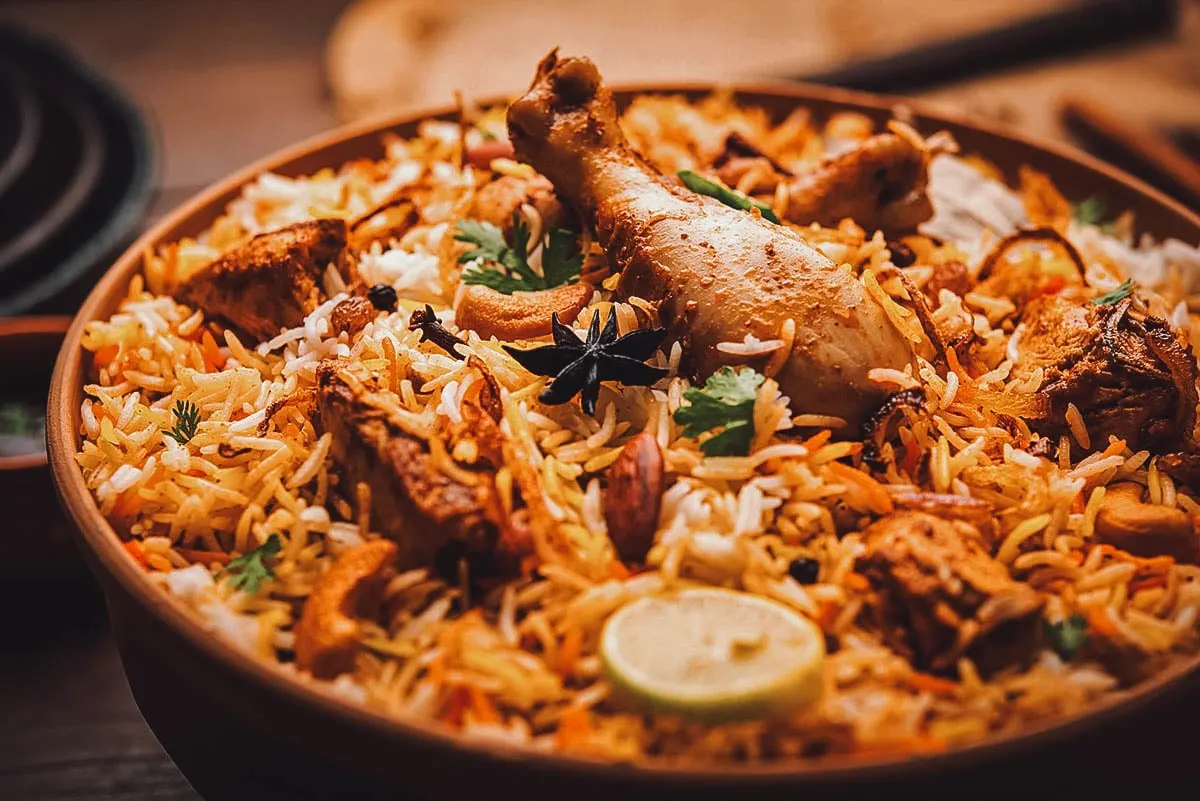
Photo by StockImageFactory.com
14. Halwa Puri
In the midst of all the bread and rice dishes that have been listed in this Pakistani food guide, halwa puri (or halwa poori) is a stand-out. This sweet dish has two main components – semolina pudding and fried flatbread. It’s typically eaten for breakfast though it can also be served during religious festivities.
With just the right amounts of sugar and milk, the semolina pudding is delectably soft and creamy. Nuts like pistachio and almonds are optional but they can be included to impart texture to the dish.
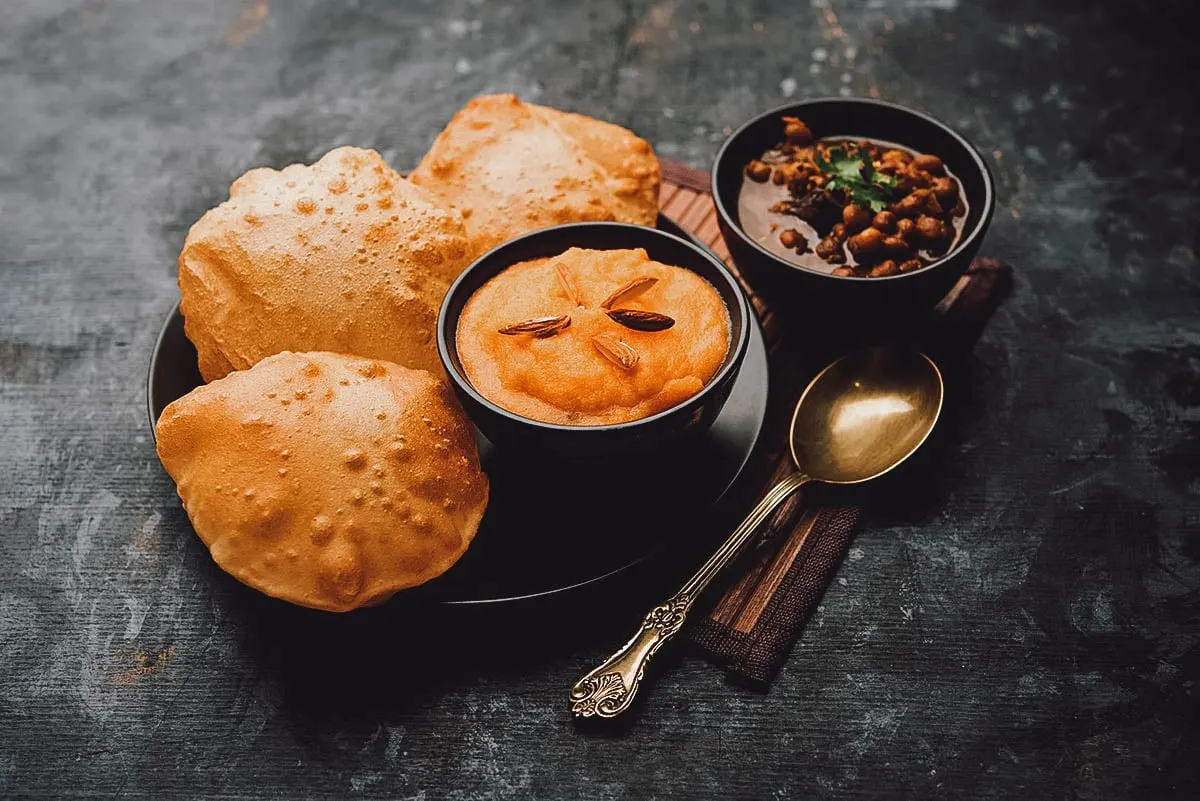
Photo by Indian Food Images
15. Paratha
Paratha is a type of unleavened flatbread that can be eaten as is for breakfast or paired with curries and stews for lunch.
Popular in Pakistan and throughout the Indian subcontinent, the word paratha literally means “layers of cooked dough”. It’s largely associated with South Asian cuisine though versions of it have become popular in many other countries as well like Singapore, Malaysia, and Myanmar.
When done right, this tasty Pakistani flatbread made with finely ground whole wheat flour is both crispy and flaky in texture. Pan-fried till toasty, it’s an easy-to-like dish that every visitor to Pakistan will surely appreciate.
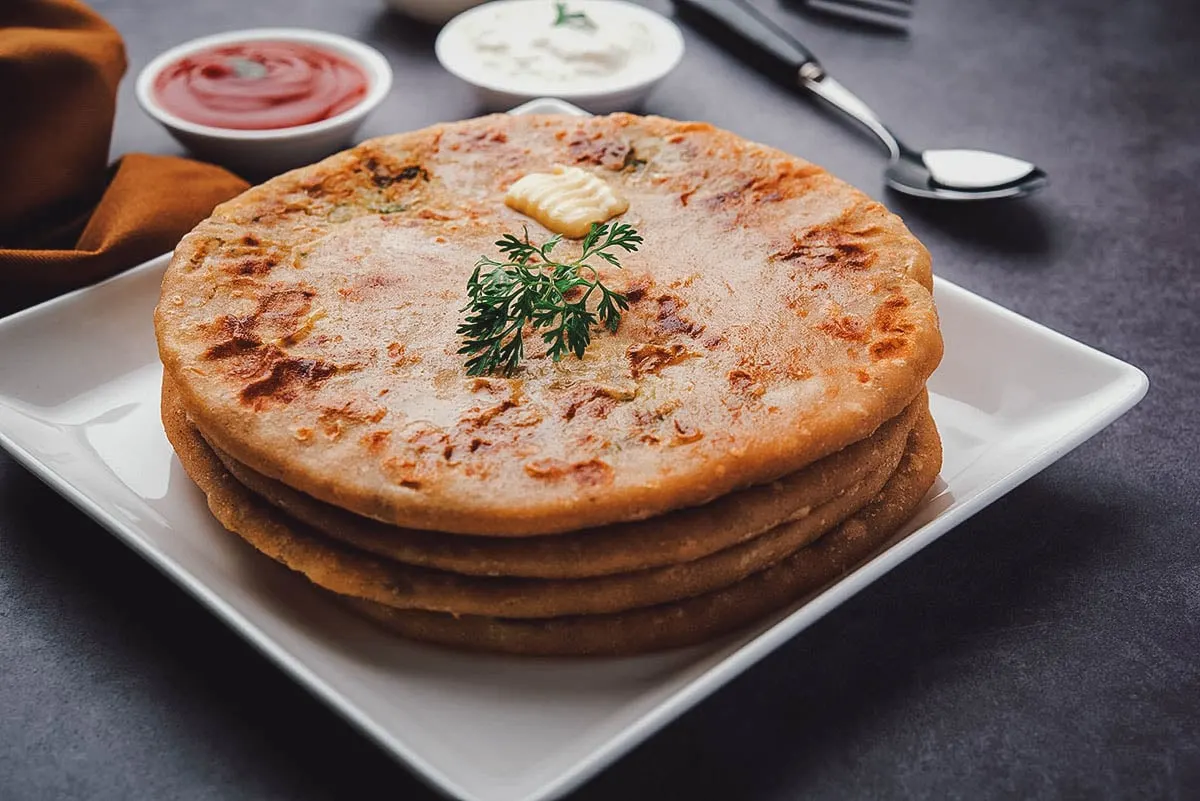
Photo by StockImageFactory.com
DESSERTS
16. Kheer (Pakistani Rice Pudding)
Kheer gets its name from the Sanskrit word for “milk”. A creamy and sweet dish, this Pakistani rice pudding is commonly served during Eid al Fitr.
Properly made kheer has a consistency that’s neither too runny nor too thick. It’s spiced with a variety of fragrant ingredients like cloves, saffron, and nutmeg before being garnished with toppings like cashews, dried fruits, and green cardamom.
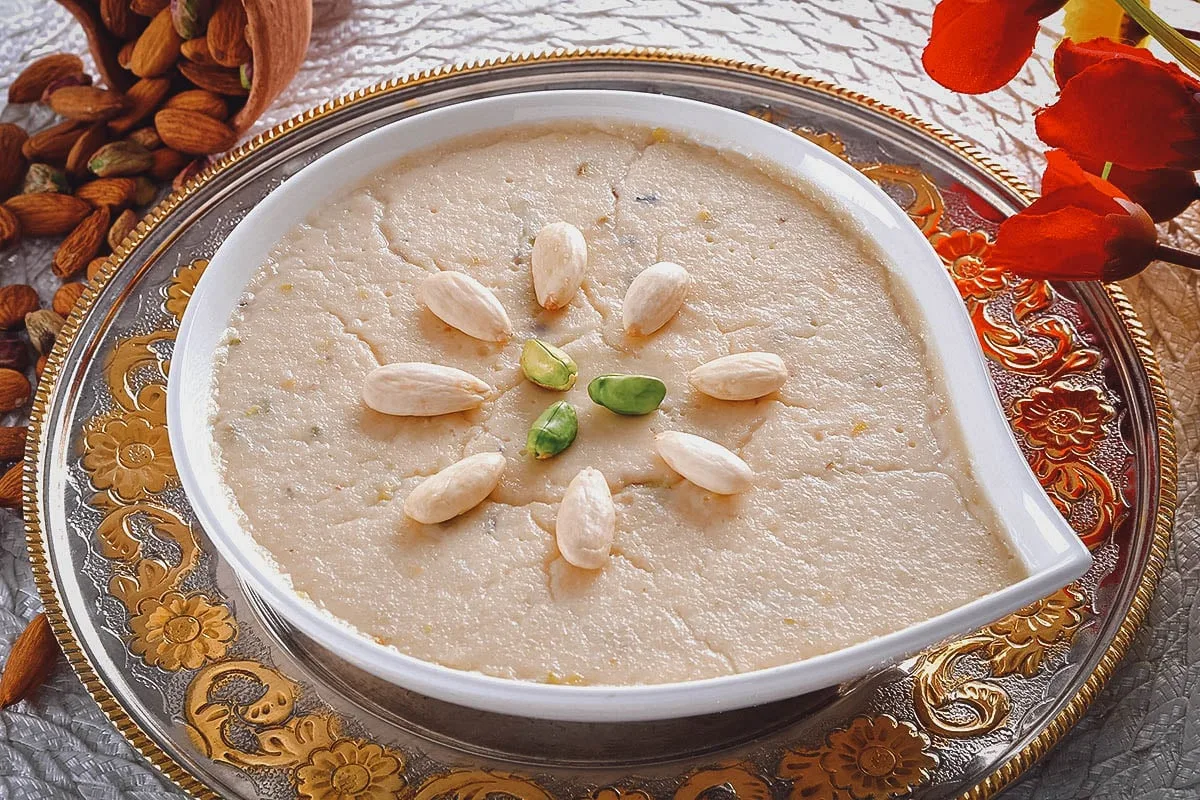
Photo by highviews
17. Falooda
You can’t talk about the best Pakistani desserts without including this summertime delicacy. Whether consumed as a beverage or eaten with a spoon, falooda is an ice cream dessert that’s delightfully refreshing and unapologetically sweet.
Falooda is made with a plethora of ingredients like vermicelli noodles, jellies, and chia or basil seeds soaked in milk. Often served with ice cream, its use of rose-flavored sugar syrup acts as a food coloring that gives the dessert its distinct pink hue.
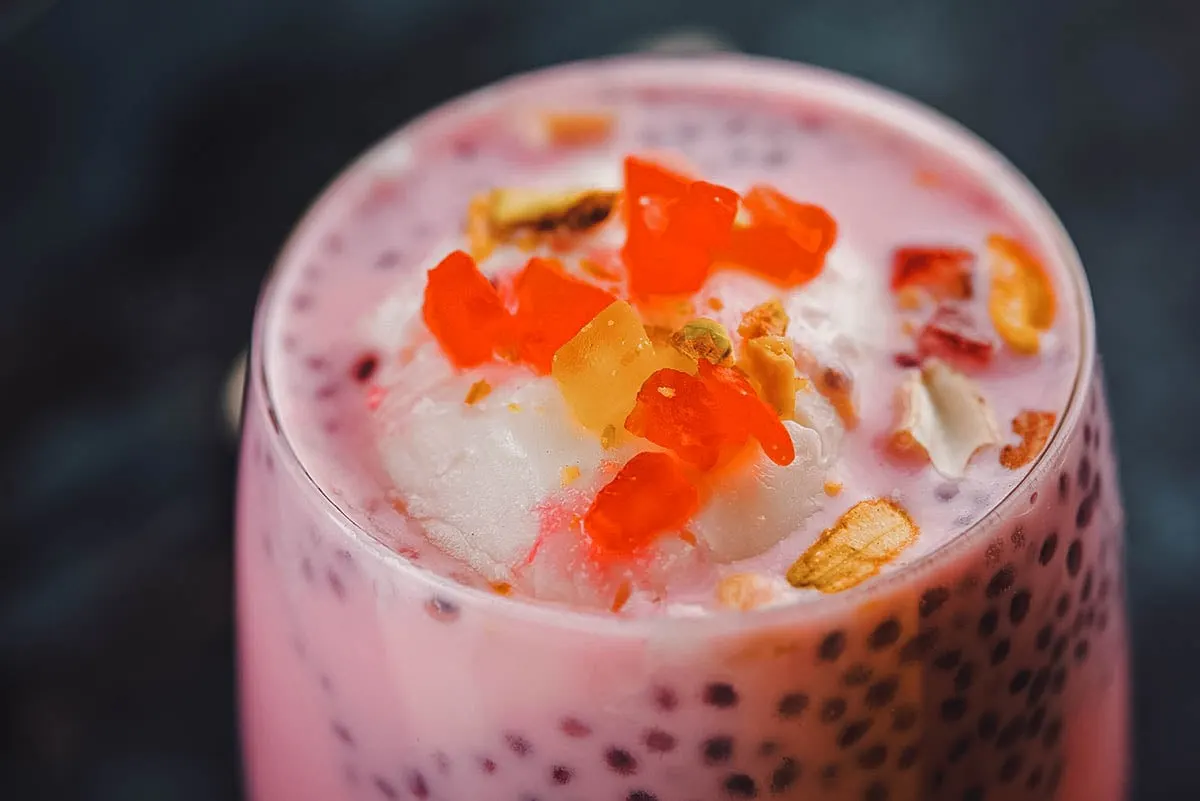
Photo by Indian Food Images
18. Zarda
Zarda is another tantalizingly sweet dessert that Pakistan shares with the rest of the Indian subcontinent. Known for its inviting yellow-orange hue, this sweet rice dish is prepared by cooking long-grain rice in clarified butter and then coating them in sugar syrup.
Eaten with an assortment of dry fruits, nuts, and a generous amount of raisins, zarda is an explosion of color and texture. It should come as no surprise then that this memorable treat tastes just as lovely as it looks.
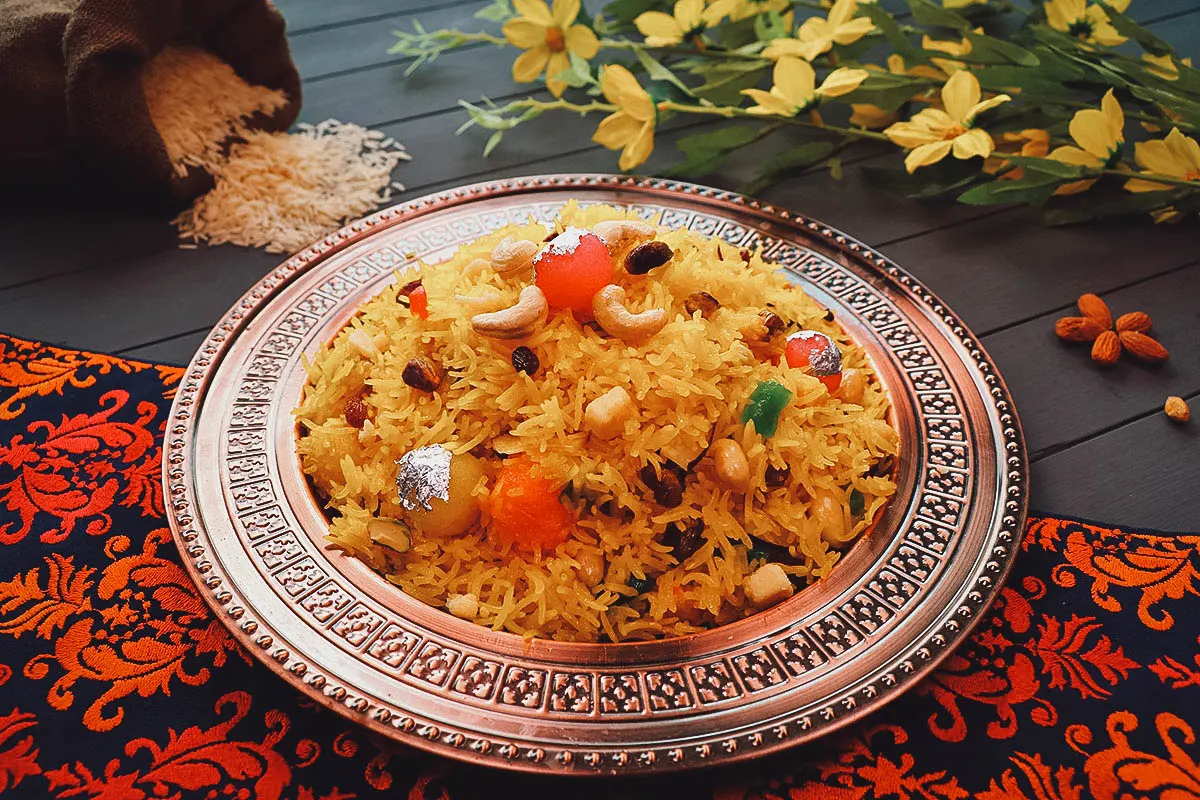
Photo by SooperChef
19. Gajrela
If you’re looking for a dessert that’s both satisfying and healthy, then look no further than gajrela. It’s also known as “gajar ka halwa”, with gajar meaning “carrot” in Hindi and halwa being the Arabic word for “sweet”.
Gajrela is essentially a carrot-based pudding that’s made with an abundance of khoya (dried milk that’s been thickened in an iron pan), sugar, and nuts. It’s best enjoyed during winter though it’s also traditionally prepared for religious events.
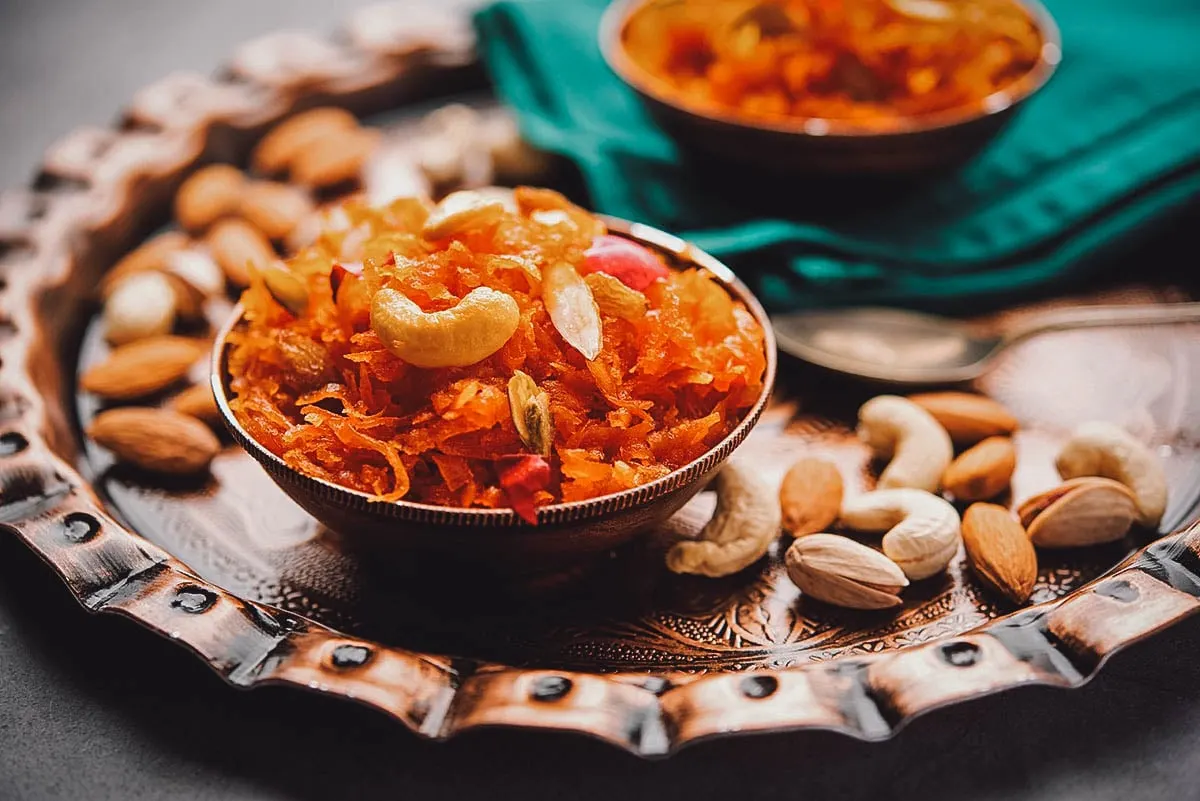
Photo by StockImageFactory.com
20. Gulab Jamun
A dessert fit for only the most joyous of celebrations, gulab jamun is bound to impress anyone with a sweet tooth.
Gulab jamun means “rose water berry” in Hindi. Popular throughout the Indian subcontinent, this delicious dessert consists of little fried dough balls traditionally made from khoya. The fried dough balls are doused with simple syrup and garnished with almonds or cashews before serving.
Gulab jamun has a floral flavor that’s sure to entice even the most dessert-averse travelers. It can be served cold, hot, or at room temperature. When served hot, it’s often enjoyed with a scoop of ice cream or kulfi (cold dairy dessert).
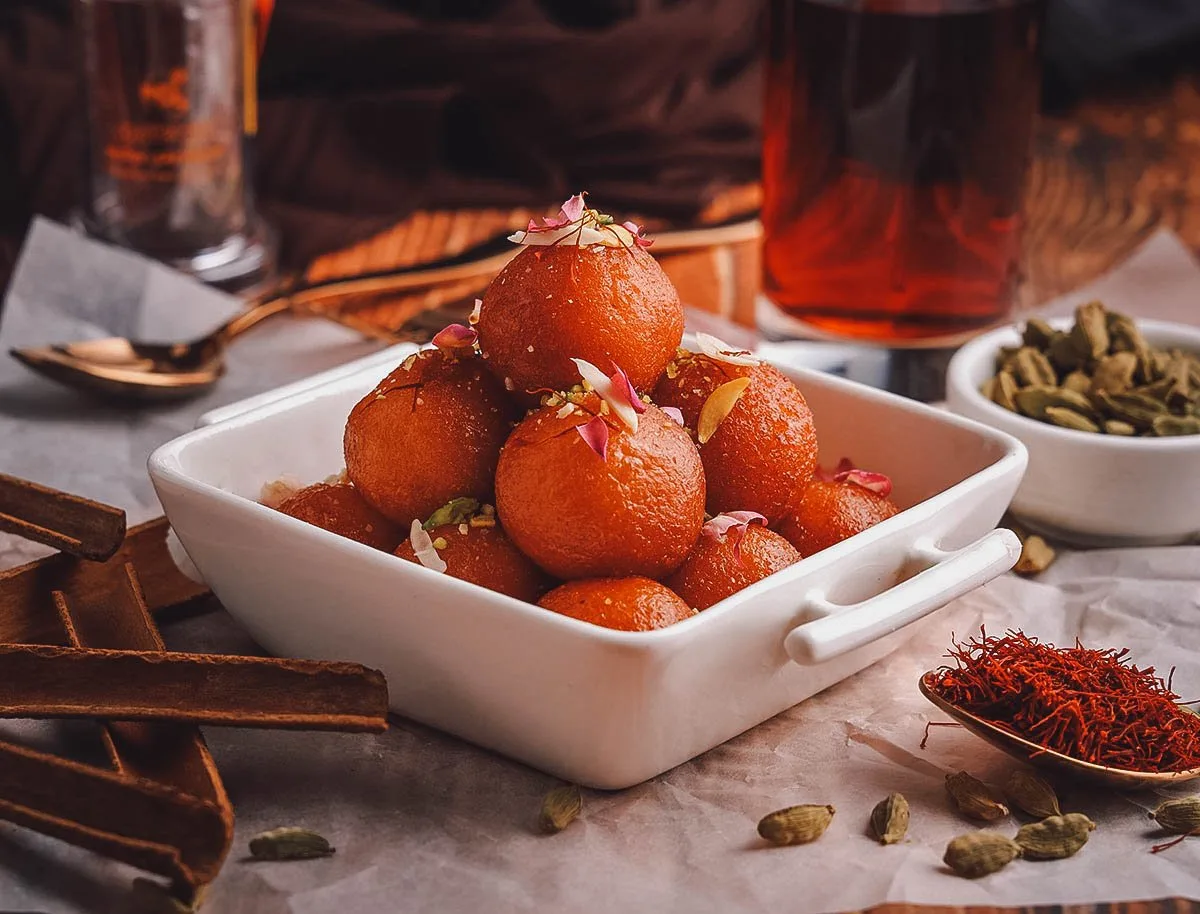
Photo by Najib Habib
FINAL THOUGHTS ON TRADITIONAL PAKISTANI FOOD
As previously mentioned, Pakistan is a country full of picturesque and historically significant attractions. You could easily lose yourself in the presence of its many breathtaking natural wonders.
On top of that, the nation is home to an enormous population that prides itself on its rich and diverse cultural identity. Given the sum of these favorable aspects, no one can deny that Pakistan is a destination that’s worth visiting sooner rather than later.
That said, with dishes ranging from spicy curries to sweet rice desserts, the gustatory experience offered by Pakistani cuisine is a draw on its own. Combining ingredients like rose water and jellies, or mutton with potatoes, every dish is a masterclass in flavor and balance.
Despite some dishes being similar to its neighbors, the Pakistani gastronomic experience as a whole is unlike any other. The country’s mountainous landscapes and stunning views are major draws, but so is its amazing food.
Disclosure
Some of the links in this article on popular Pakistani foods are affiliate links, meaning we’ll earn a small commission if you make a booking at no added cost to you. We really appreciate your support as it helps us write more of these free travel and food guides. Thank you!
Cover photo by Indian Food Images. Stock images via Shutterstock.


Recipes land
Saturday 27th of May 2023
Very well write up, thanks for sharing.
Arslan Khan
Wednesday 5th of April 2023
Thanks for sharing your knowledge bro.. Each and everything well explained.. I appreciate that keep it up ❤